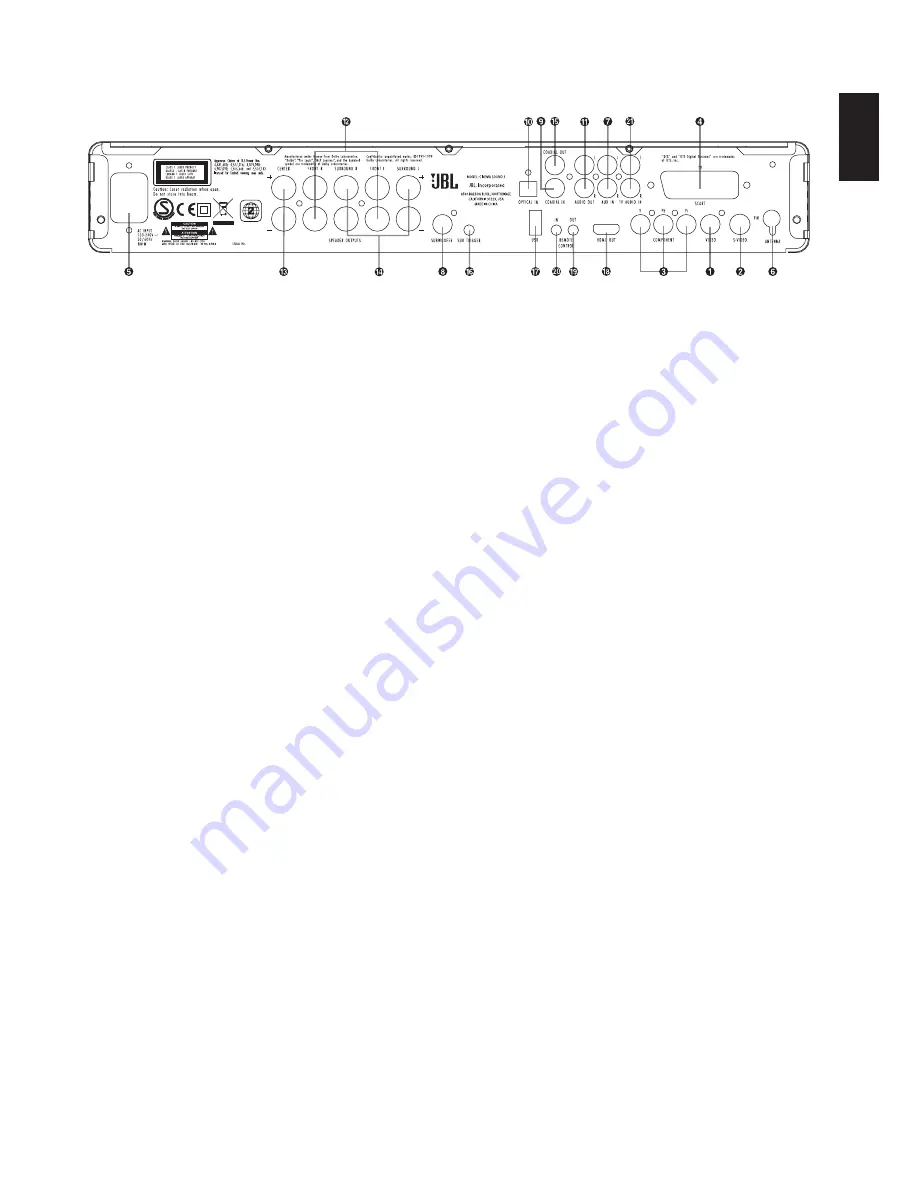
9
REAR-PANEL CONNECTIONS
0
Composite Video Output
1
S-Video Output
2
Component Video Outputs
3
SCART TV Output
4
AC Power Cord
5
FM Antenna
6
Audio In
7
Subwoofer Output
8
Coaxial Digital Input
9
Optical Digital Input
A
Analog Audio Outputs
B
Front Speaker Outputs
C
Center Speaker Outputs
D
Surround Speaker Outputs
E
Coaxial Digital Output
F
Subwoofer Trigger Output
G
USB On-The-Go Input
H
HDMI Output
I
Remote IR Output
J
Remote IR Input
K
TV Audio In
0
Composite Video Output:
Connect this jack to the video input on
a television or video projector.
1
S-Video Output:
Connect this jack to the S-video input on a
television or video projector.
2
Component Video Outputs:
These outputs carry the component
video signals for connection to display monitors with component
video inputs. For standard analog TVs or projectors with inputs
marked Y/Pr/Pb or Y/Cr/Cb, connect these outputs to the corre-
sponding inputs. If you have a high-definition TV or projector that is
compatible with high-scan-rate progressive video, connect these
jacks to the “HD Component” inputs. Note that if you are using a
progressive scan display device, then ”Progressive” must be
selected in the Video Setup menu, in order to take advantage of the
progressive-scan circuitry. See page 20 for more information on
progressive-scan video.
IMPORTANT:
These jacks should NOT be connected to standard
composite video inputs.
3
SCART Out (TV):
If your TV has a SCART socket, you can con-
nect a SCART cable to your TV and to your DVD player for
improved video quality. The SCART cable carries both audio and
video. You can select composite video or RGB video for that SCART
connector’s video output signal.
4
AC Power Cord:
Connect this plug to an AC outlet. If the outlet is
controlled by a switch, make sure it is in the On position.
5
FM Antenna:
Connect to the supplied FM antenna.
6
Audio In:
Connect to a line-level analog audio source: TV, tape
player, Minidisc, PC, etc.
7
Subwoofer Output:
Connect to the SUB/LFE input on the sub-
woofer.
8
Coaxial Digital Input:
Connect the coax digital output from a
DVD player, HDTV receiver, LD player, MD player, satellite receiver
or CD player to this jack. The signal may be either a Dolby Digital
signal, DTS signal or a standard PCM digital source. Do not con-
nect the RF digital output of an LD player to these jacks.
9
Optical Digital Input:
Connect the optical digital output from a
DVD player, HDTV receiver, LD player, MD player, satellite receiver
or CD player to this jack. The signal may be either a Dolby Digital
signal, DTS signal or a standard PCM digital source.
A
Analog Audio Outputs:
Connect these jacks to the analog audio
input on a TV set or external audio system for analog audio play-
back or to the RECORD/INPUT jacks of an audio recorder for
recording.
B
Front Speaker Outputs:
Connect these outputs to the ma
or – terminals on your left and right speakers. In conformance with
the new CEA color code specification, the White terminal is the
positive (+) terminal that should be connected to the red (+) termi-
nal on Front Left speaker with the older color coding, while the Red
terminal is the positive (+) terminal that should be connected to the
red (+) terminal on Front Right speaker. Connect the black (–)
terminals on the CS to the black (–) terminals on the speakers. See
page 14 for more information on speaker polarity.
C
Center Speaker Outputs:
Connect these outputs to the matching
+ and – terminals on your center channel speaker. In conformance
with the new CEA color code specification, the Green Terminal is
the positive (+) terminal that should be connected to the red (+) ter-
minal on speakers with the older color coding. Connect the black
(–) terminal on the CS to the black negative (–) terminal on your
speaker. See page 14 for more information on speaker polarity.
D
Surround Speaker Outputs:
Connect these outputs to the match-
ing + and – terminals on your surround channel speakers. In con-
formance with the new CEA color-code specification, the Blue ter-
minal is the positive (+) terminal that should be connected to the
red (+) terminal on the Surround Left speaker with older color cod-
ing, while the Gray terminal should be connected to the red (+) ter-
minal on the Surround Right speaker with the older color-coding.
Connect the black (–) terminal on the CS to the matching black neg-
ative (–) terminals for each surround speaker. See page 14 for more
information on speaker polarity.
NOTE:
You’ll find more details about all audio/video connections
under Setup and Connections on the following pages.
E
Coaxial Digital Output:
Connect this jack to the matching digital
input connector on a digital recorder (e.g., CD-R or MiniDisc
recorder).
English










































